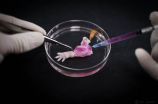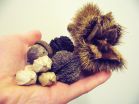(Press-News.org) What if your doctor told you that your weight is somewhere between 100 and 400 lbs.? With any ordinary scale every patient can do better at home. Yet, one patient can't: the Milky Way. Even though today we peer deeper into space than ever before, our home galaxy's weight is still unknown to about a factor of four. Researchers at Columbia University's Astronomy Department have now developed a new method to give the Milky Way a more precise physical checkup.
The Milky Way consists of roughly 100 billion stars that form a huge stellar disk with a diameter of 100-200 thousand light years. The Sun is part of this structure, hence, when we look into the sky, we look right into a gigantic disk of stars. The vast number of stars and the huge extent on the sky make it hard to measure fundamental quantities for the Milky Way, such as its weight.
An international team of scientists led by Columbia University researcher Andreas Küpper used stars outside this disk, which orbit around the Milky Way in a stream-like structure, to weigh the Milky Way to high precision. In a new study published in The Astrophysical Journal, the team demonstrates that such streams, produced by dissolving globular clusters, can be used to measure not only the weight of our Galaxy, but can also be exploited as yardsticks to determine the location of the Sun within the Milky Way.
"Globular clusters are compact groups of thousands to several millions of stars that were born together when the universe was still very young," said Küpper. "They orbit around the Milky Way and slowly disintegrate over the course of billions of years, leaving a unique trace behind. Such star streams stick out from the rest of the stars in the sky as they are dense and coherent, much like contrails from airplanes easily stick out from regular clouds."
The researchers used data from the Sloan Digital Sky Survey, which scanned the sky of the Northern Hemisphere for about 10 years to create a comprehensive catalog of stars in the sky. The stream they tested the new technique on was produced by a globular cluster named Palomar 5, and had already been discovered in 2001 high above the Galactic disk. Eduardo Balbinot, coauthor on the current study from the University of Surrey in England, revisited the Sloan data and detected density wiggles in the stream of Palomar 5.
"We found the wiggles to be very pronounced and regularly spaced along the stream," said Balbinot. "Such variations cannot be random."
It is these wiggles that allow the researchers to gain the unprecedented precision of their measurement. Using the Yeti supercomputer of Columbia University, they created several million models of the stream in different realizations of the Milky Way. From these models and from comparing the wiggle pattern of the models to the observations, they were able to infer the mass of the Milky Way within a radius of 60,000 light years to be 210 billion times the mass of the Sun with an uncertainty of only 20 percent. The unique pattern of the density wiggles helped significantly to rule out models of the Milky Way, which were either too heavy or too skinny.
"An important advance in this work was using robust statistical tools - the same ones used to study changes in the genome and employed by internet search engines to rank websites," explained Ana Bonaca, a coauthor from Yale University. This rigorous approach helped in achieving the high precision in weighing the Milky Way."
"Such measurements have been tried before with different streams, but the results were always quite ambiguous," added Professor Kathryn Johnston, coauthor of the study and chair of the Columbia Astronomy Department. "Our new measurement breaks these ambiguities by exploiting the unique density pattern that Palomar 5 created as it orbited around the Milky Way for the past 11 billion years."
In the future, the researchers aim to use more structures like the Palomar 5 stream to gain an even higher precision and to create the most realistic model of the Milky Way to date. From the improved precision the scientists hope to learn about the formation and composition of our home galaxy, and to understand how the Milky Way compares with other galaxies in the Universe. So far, the results indicate that the Milky Way is a healthy patient - neither too skinny nor too heavy for its size.
INFORMATION:
Lead author of the study "Globular Cluster Streams as Galactic High-Precision Scales - the Poster Child Palomar 5", Andreas Küpper, is a Hubble Fellow at the Astronomy Department of Columbia University. The Hubble Fellowship grants are awarded by the Space Telescope Science Institute, which is operated by the Association of Universities for Research in Astronomy, Inc., for NASA.
PHILADELPHIA--(June 2, 2015)--Senescence, a phenomenon in which cells cease to divide and grow, can be caused by everything from natural DNA damage to treatment with chemotherapy. However, several mechanisms allow for cells to bypass senescence and grow out of control, eventually becoming cancerous. Now, scientists at The Wistar Institute have identified how a specific variant of a key protein complex found in human cells called condensin can reorganize a cell's genetic architecture in such a way as to promote senescence, making it an important facilitator in a cell's ...
A team of Massachusetts General Hospital (MGH) investigators has made the first steps towards development of bioartificial replacement limbs suitable for transplantation. In their report, which has been published online in the journal Biomaterials, the researchers describe using an experimental approach previously used to build bioartificial organs to engineer rat forelimbs with functioning vascular and muscle tissue. They also provided evidence that the same approach could be applied to the limbs of primates
"The composite nature of our limbs makes building a functional ...
Who says you can't do two things at once and do them both well?
A new University of Florida study challenges the notion that multi-tasking causes one or both activities to suffer. In a study of older adults who completed cognitive tasks while cycling on a stationary bike, UF researchers found that participants' cycling speed improved while multi-tasking with no cost to their cognitive performance.
Results of the study, which was supported by a grant from the National Institute on Aging, were published May 13 in the journal PLOS ONE.
The discovery was a surprise finding ...
COLUMBUS, Ohio - A new nationwide study reveals that the kind of cities that attract college graduates has changed since the 1990s.
In the 1990s, grads were moving to cities with fast-growing "smart" industries in fields like high tech, the study found. But since 2000, with a less vibrant national economy, college graduates are flocking toward the biggest cities with the biggest labor markets and the best chances of landing a job.
In fact, the effect of city population size in attracting college grads was nearly four times as large in the 2000s as it was in the 1990s, ...
(New York, NY, June 1, 2015)-- The Big Apple is one of the most walkable cities in the nation, providing many opportunities for physical activity, and New Yorkers are more likely to exercise regularly than the average U.S. adult. But they are also sitting far more than what is considered healthy.
According to a new study published by the U.S. Centers for Disease Control and Prevention in its journal Preventing Chronic Disease, the average New York City resident sits more than seven hours a day--greatly exceeding the three hours or more per day that is associated with ...
HOUSTON - (June 2, 2015) - Hispanics and women in Texas showed the largest percentage of reductions in rates of uninsured since enrollment began in the Affordable Care Act's (ACA) Health Insurance Marketplace, according to a new report released today by the Episcopal Health Foundation and Rice University's Baker Institute for Public Policy.
The report found that from September 2013 to March 2015, the percentage of Hispanics without health insurance fell 38 percent (from 39.1 percent uninsured to 24.3 percent), more than any other ethnic group. The percentage of uninsured ...
HOUSTON - (June 2, 2015) - Women who suffer from fibromyalgia benefit from a treatment regimen in a hyperbaric oxygen chamber, according to researchers at Rice University and institutes in Israel.
A clinical trial involving women diagnosed with fibromyalgia showed the painful condition improved in every one of the 48 who completed two months of hyperbaric oxygen therapy. Brain scans of the women before and after treatment gave credence to the theory that abnormal conditions in pain-related areas of the brain may be responsible for the syndrome.
Results of the study ...
BUFFALO, N.Y. -- A new study by University at Buffalo geographers explores how humans altered the arboreal make-up of Western New York forests before European settlers arrived in large numbers.
The research looked at land survey data from around 1799-1814, and used this information to model which tree species were present in different areas of Chautauqua County, New York, at that time.
The analysis placed hickory, chestnut and oak trees in larger-than-expected numbers near the historical sites of Native American villages, said co-author Steve Tulowiecki, who conducted ...
MAYWOOD, Ill. - Drawing on its Jesuit Catholic heritage, Loyola University Chicago Stritch School of Medicine has long understood the importance of reflection in medical education as a key element in physician formation. With physician burnout on the rise, it is all the more integral for students to learn ways to engage better with the challenges faced in the medical profession. Stritch faculty members believe reflection is a fundamental tool to help students process and cope with the tremendous physical, emotional, and mental pressure that can accompany their vocation.
These ...
Hamilton, ON (June 2, 2015) - What causes us to lose muscle strength as we age and how exercise can prevent it from happening has never been thoroughly understood, but McMaster University researchers have discovered a key protein required to maintain muscle mass and muscle strength during aging.
This important finding means new and existing drugs targeting the protein may potentially be used to preserve muscle function during aging.
"We found that the body's fuel gauge, AMP-activated protein kinase (AMPK), is vital to slow muscle wasting with aging," said Gregory Steinberg, ...


